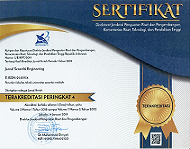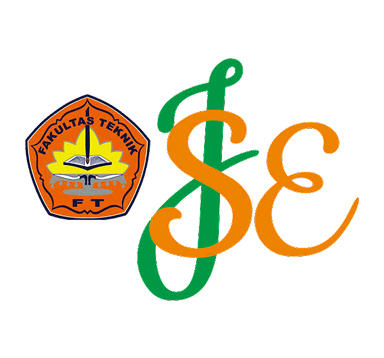Penerapan Lubang Resapan Biopori Dalam Meningkatkan Laju Infiltrasi di Desa Sungai Langka
Keywords:
air hujan, limpasan air, laju infiltrasi, lubang resapan biopori, desa sungai langkaAbstract
The Sungai Langka Village area lacks drainage and has elevated roads, causing water to run off during rainfall and onto the roads and into people's yards. In these conditions, efforts will be made to utilise water runoff as an alternative water source. This study aims to determine the effect of infiltration in the application of biopori infiltration pit technology. This research was conducted using a quantitative approach. The data were processed using the Horton method and analysed descriptively. Infiltration data was collected in situ in the field. The data compared the infiltration rate before and after the application of biopori infiltration pits. The results showed that the infiltration rate was constant at 46 cm/hour, 44 cm/hour, 32 cm/hour, 36 cm/hour and 32 cm/hour before the application of biopori infiltration pits. Meanwhile, the infiltration rates after the application of biopore infiltration pits were 110 cm/hour, 78 cm/hour, 70 cm/hour, 104 cm/hour and 138 cm/hour. The aim of the study was to determine how increasing infiltration rates can reduce water runoff and increase groundwater reserves.
References
[1] “Peraturan Menteri Negara Lingkungan Hidup Nomor 12 Tahun 2009 Tentang Pemanfaatan Air Hujan Menteri Negara Lingkungan Hidup”.
[2] E. Victorianto And S. Qomariyah, “Pengaruh Lubang Resapan Biopori Terhadap Limpasan Permukaan”.
[3] S. Sambayan -Jurnal Pengabdian Kepada Masyarakat, R. Chandra Wijaya, H. Anwar, A. T. Cahaya S, And S. Erfani, “Implementasi Teknologi Pengolahan Air Bersih Di Desa Sungai Langka Dengan Metode Rainwater Harvesting,” 2020.
[4] P. Hasan, A. A. Hidayat, N. S. Ersa, And R. Maulana, “Analisis Pengaruh Lubang Resapan Biopori Dalam Upaya Konservasi Air Terhadap Genagan Air Minimal Di Gampong Rayeuk Kareung,” Teras Jurnal : Jurnal Teknik Sipil, Vol. 15, No. 1, Pp. 88–99, Mar. 2025, Doi: 10.29103/Tj.V15i1.1206.
[5] Thioritz Stevy, “Uji_In_Situ_Kenaikan_Laju_Infiltrasi_Aki,” Jurnal Ilmiah Teknik Elektro, Informatika, Mesin Dan Sipil, Vol. 5, No. 1, P. 1, May 2011.
[6] B. O. Paga’ And R. Reniana, “Perhitungan Laju Infiltrasi Pada Kebun Percontohan Fakultas Teknologi Pertanian Universitas Papua,” Jurnal Agritechno, Pp. 36–41, Apr. 2021, Doi: 10.20956/At.V14i1.409.
[7] M. M. Harfadli, M. Ulimaz, C. K. Banaget, M. Wulandari, R. A. T. Senobaan, And H. Santosa, “Analisis Kebutuhan Lubang Resapan Biopori Pada Daerah Rawan Banjir Di Kelurahan Batu Ampar,” Jurnal Sains Terapan, Vol. 9, No. 1, Pp. 45–52, 2023.
[8] M. R. Arrosyidah, Djayus, Mislan, And R. Munir, “Laju Infiltrasi Air Di Lubang Biopori Pada Berbagai Jenis Tanah Di Kelurahan Loa Bakung,” Jurnal Geosains Kutai Basin, Vol. 7, No. 1, Pp. 1–8, Feb. 2024.
[9] Y. Sriwahyuni, C. Thesisa Ilmawan Dzinnur, And S. Agung Wibawa, “Pengaruh Penambahan Sampah Organik, Bioaktivator Dan Fases Hewan Pada Lubang Resapan Biopori (Lrb) Terhadap Infiltrasi Dan Permeabilitas Tanah,” 2020.
[10] R. Ristianingsih Badu, W. Lukum, M. R. Tahir, F. Sm, And T. Lingkungan, “Efektivitas Teknologi Biopori Dengan Pengolahan Sampah Organik Untuk Meningkatkan Laju Infiltrasi Tanah,” 2023.
[11] I. K. Sudiana, I. P. Parwata, And P. L. P. Kristiyanti, “Lubang Resapan Biopori Sebagai Solusi Penanganan Masalah Sampah Dan Peningkatan Resapan Air,” Proceeding Senadimas Undiksha, Pp. 733–740, 2021.
[12] C. Yunagardasari, A. K. Paloloang, And A. Monde, “Model Infiltrasi Pada Berbagai Penggunaan Lahan Di Desa Tulo Kecamatan Dolo Kabupaten Sigi Infiltration Model In Different Land Use In Desa Tulo Kecamatan Dolo Kabupaten Sigi,” E-J. Agrotekbis, Vol. 5, No. 3, Pp. 315–323, 2017.
[13] U. Muhammadiyah Yogyakarta, “Pengukuran Nilai Infiltrasi Lapangan Dalam Upaya Penerapan Sistem Drainase Berkelanjutan Di Kampus Umy Nursetiawan, Arwi Imam Pratama.”
[14] D. Vera Herviana And E. Rini Indrayatie Dan Asysyifa Program Studi Kehutanan, “Kajian Sifat Fisik Tanah Dan Laju Infiltrasi Di Berbagai Tegakan Study Of The Soil Physical Properties And Infiltration Rate In Various Tree Stands,” 2021.
[15] S. Aulia, M. S. A. Putri, D. A. Prasidya, And N. L. Syakbanah, “Pengaruh Konsentrasi Bioaktivator Effective Microorganism 4 Terhadap Waktu Penyerapan Air, Massa, Dan Kualitas Kompos Pada Lubang Biopori,” Jurnal Ecosolum, Vol. 12, No. 2, Pp. 163–177, Dec. 2023, Doi: 10.20956/Ecosolum.V12i2.27857.
[16] A. Wulida Habibiyah, S. Widyastuti, And P. Studi Teknik Lingkungan Fakultas Teknik Sipil Dan Perencanan, “Pengaruh Jenis Sampah, Variasi Umur Sampah Terhadap Laju Infiltrasi Lubang Resapan Biopori (Lrb),” 2016.
Downloads
Published
Issue
Section
License
Copyright (c) 2025 Nadia Dhannov, Irhamni, Fajriharish Nur Awan, Mutiara Fajar, Nabila Putriyandri Alifa, Yuni Lisafitri, Sillak Hasiany (Author)

This work is licensed under a Creative Commons Attribution 4.0 International License.












